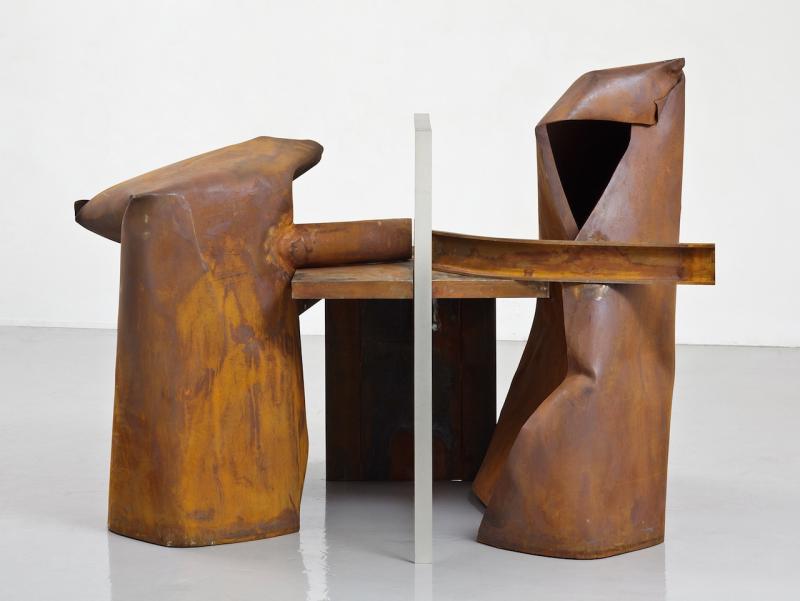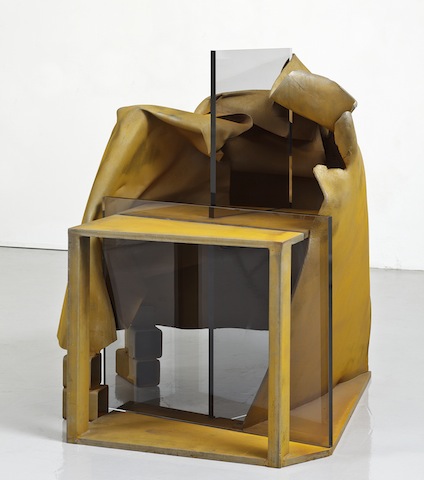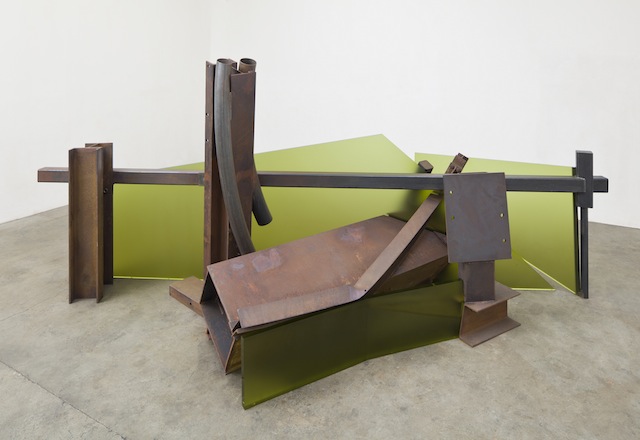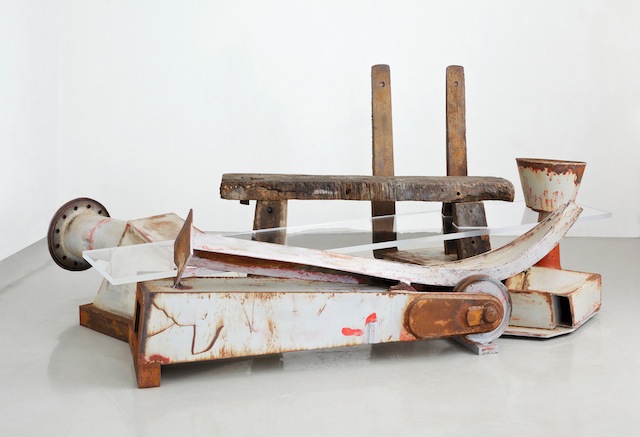Anthony Caro: The Last Sculptures, Annely Juda | reviews, news & interviews
Anthony Caro: The Last Sculptures, Annely Juda
Anthony Caro: The Last Sculptures, Annely Juda
New formulations and materials preoccupied the late sculptor to the end

Late Titian, Late Rembrandt, Late Picasso, Late Matisse…. What is it with Late that seems to give some artists a Golden Age irradiated by a kind of sublime carelessness, a genuine sense of anything goes? A life spent learning means that in the end it might be worn lightly and the imagination set free. Of course, such a sublime coda is not given to all, as many an artist descends into self-parody, rather than ascending into a kind of upward free-fall.
But on the evidence of a selection of the sculptures Anthony Caro made in the last two years of his long life, he was continuing to delight in the motifs of the past five decades, and to expand on his constant preoccupations with new formulations and new materials.
He often riffed on older masterpieces of painting and sculpture. In the Nineties he worked on a massive grouping of several sculptures called The Last Judgment. Only six years ago an entire church in northern France became permanently replete with Caro’s Chapel of Light, the elaborate and endlessly fascinating sculptures in various kinds of metal subliminally recalling Christian iconography: the choreography of the posing of saints, the groupings of the Holy Family.
 In his last two years, oddly energised by a huge project for a three-block-long procession on Park Avenue in New York, that in the end could not be realised, Caro turned to Perspex, mixing its transparency with the roughness of his steel forms, including found remnants. The latter recalled the hardiness of massive constructions and hinted at Caro’s own engineering studies before art lured him.
In his last two years, oddly energised by a huge project for a three-block-long procession on Park Avenue in New York, that in the end could not be realised, Caro turned to Perspex, mixing its transparency with the roughness of his steel forms, including found remnants. The latter recalled the hardiness of massive constructions and hinted at Caro’s own engineering studies before art lured him.
Here are two quite extraordinary meditations, in folded steel and Perspex, on Cézanne’s The Cardplayers: Sackbut, 2011-12 (main picture), and Card Game, 2013 (pictured above). Here the peasants absorbed in the game are transmuted into metal draped with awkward grace, further enlivened by a sheet of neutral Perspex. An aspect of these comparatively small – for Caro – sculptures is the touching way the two crumpled players in Sackbut seem in a kind of relationship: hunched in concentration over the invisible cards, furtively glancing at each other, assessing body language – all in a totally abstract idiom. Card Game, too, is a visual rendering of a form crumpled in a kind of intense concentration.
 Caro often used a frosted colour – frosted raspberry, frosted lime – for the plastic. River Run, 2013 (pictured above) deploys angled sheets of translucent green plastic, almost suggesting the possibilities of watery movement, with metal architectural forms surprisingly suggestive of bridges, flowing river, paths, road, even, fancifully, a boat about to launch. No matter how abstract, and they are, Caro is always allusive as indicated by his titles. End of Time, 2013, uses brilliant scarlet Perspex cut out to indicate a sun, perhaps at the moment of apocalypse, blazing above a formation of industrial components, perhaps the kind of heavy metal that has just resisted a final meltdown.
Caro often used a frosted colour – frosted raspberry, frosted lime – for the plastic. River Run, 2013 (pictured above) deploys angled sheets of translucent green plastic, almost suggesting the possibilities of watery movement, with metal architectural forms surprisingly suggestive of bridges, flowing river, paths, road, even, fancifully, a boat about to launch. No matter how abstract, and they are, Caro is always allusive as indicated by his titles. End of Time, 2013, uses brilliant scarlet Perspex cut out to indicate a sun, perhaps at the moment of apocalypse, blazing above a formation of industrial components, perhaps the kind of heavy metal that has just resisted a final meltdown.
Bench, 2011-13 (pictured below), with its playful splashes of scarlet paint, is, for all its sharp angles and geometric playfulness, somehow also seductive, asking us to sit on one of its broad expanses. But it is of course look, don’t touch, which is a pity because Caro’s play with textures and surfaces – in this case, wood, Perspex and metal – is characteristically and idiosyncratically appealing.
 Caro was credited with being among the handful of artists who, in a sense, demystified sculpture, making it sit on the floor, not on a plinth, expanding its materials, using industrial paint and industrial remnants. But even more, this is sculpture absolutely in the round, almost impossible to photograph as it has to be encircled with new vistas from every angle. There is no one view, and in these last sculptures the very density of forms is an essential part of this curiously affecting final refinement. This is sculpture in ludic mode, playing on our subliminal responses to make stories, even narratives, out of roughly hewn geometries.
Caro was credited with being among the handful of artists who, in a sense, demystified sculpture, making it sit on the floor, not on a plinth, expanding its materials, using industrial paint and industrial remnants. But even more, this is sculpture absolutely in the round, almost impossible to photograph as it has to be encircled with new vistas from every angle. There is no one view, and in these last sculptures the very density of forms is an essential part of this curiously affecting final refinement. This is sculpture in ludic mode, playing on our subliminal responses to make stories, even narratives, out of roughly hewn geometries.
Explore topics
Share this article
The future of Arts Journalism
You can stop theartsdesk.com closing!
We urgently need financing to survive. Our fundraising drive has thus far raised £49,000 but we need to reach £100,000 or we will be forced to close. Please contribute here: https://gofund.me/c3f6033d
And if you can forward this information to anyone who might assist, we’d be grateful.

Subscribe to theartsdesk.com
Thank you for continuing to read our work on theartsdesk.com. For unlimited access to every article in its entirety, including our archive of more than 15,000 pieces, we're asking for £5 per month or £40 per year. We feel it's a very good deal, and hope you do too.
To take a subscription now simply click here.
And if you're looking for that extra gift for a friend or family member, why not treat them to a theartsdesk.com gift subscription?
more Visual arts
 'We are bowled over!' Thank you for your messages of love and support
Much-appreciated words of commendation from readers and the cultural community
'We are bowled over!' Thank you for your messages of love and support
Much-appreciated words of commendation from readers and the cultural community
 Folkestone Triennial 2025 - landscape, seascape, art lovers' escape
Locally rooted festival brings home many but not all global concerns
Folkestone Triennial 2025 - landscape, seascape, art lovers' escape
Locally rooted festival brings home many but not all global concerns
 Sir Brian Clarke (1953-2025) - a personal tribute
Remembering an artist with a gift for the transcendent
Sir Brian Clarke (1953-2025) - a personal tribute
Remembering an artist with a gift for the transcendent
 Emily Kam Kngwarray, Tate Modern review - glimpses of another world
Pictures that are an affirmation of belonging
Emily Kam Kngwarray, Tate Modern review - glimpses of another world
Pictures that are an affirmation of belonging
 Kiefer / Van Gogh, Royal Academy review - a pairing of opposites
Small scale intensity meets large scale melodrama
Kiefer / Van Gogh, Royal Academy review - a pairing of opposites
Small scale intensity meets large scale melodrama
 Jenny Saville: The Anatomy of Painting, National Portrait Gallery review - a protégé losing her way
A brilliant painter in search of a worthwhile subject
Jenny Saville: The Anatomy of Painting, National Portrait Gallery review - a protégé losing her way
A brilliant painter in search of a worthwhile subject
 Abstract Erotic, Courtauld Gallery review - sculpture that is sensuous, funny and subversive
Testing the boundaries of good taste, and winning
Abstract Erotic, Courtauld Gallery review - sculpture that is sensuous, funny and subversive
Testing the boundaries of good taste, and winning
 Edward Burra, Tate Britain review - watercolour made mainstream
Social satire with a nasty bite
Edward Burra, Tate Britain review - watercolour made mainstream
Social satire with a nasty bite
 Ithell Colquhoun, Tate Britain review - revelations of a weird and wonderful world
Emanations from the unconscious
Ithell Colquhoun, Tate Britain review - revelations of a weird and wonderful world
Emanations from the unconscious
 Rachel Jones: Gated Canyons, Dulwich Picture Gallery review - teeth with a real bite
Mouths have never looked so good
Rachel Jones: Gated Canyons, Dulwich Picture Gallery review - teeth with a real bite
Mouths have never looked so good
 Yoshitomo Nara, Hayward Gallery review - sickeningly cute kids
How to make millions out of kitsch
Yoshitomo Nara, Hayward Gallery review - sickeningly cute kids
How to make millions out of kitsch
 Hamad Butt: Apprehensions, Whitechapel Gallery review - cool, calm and potentially lethal
The YBA who didn’t have time to become a household name
Hamad Butt: Apprehensions, Whitechapel Gallery review - cool, calm and potentially lethal
The YBA who didn’t have time to become a household name

Add comment